Penghu
The Penghu (Hokkien POJ: Phîⁿ-ô͘ or Phêⁿ-ô͘ ) or Pescadores Islands are an archipelago of 90 islands and islets in the Taiwan Strait. The largest city is Magong, located on the largest island, which is also named Magong. Covering an area of 141 square kilometers (54 sq mi), the archipelago collectively forms Penghu County of the Republic of China (Taiwan), and is the second smallest county, after Lienchiang County (the Matsu Islands).
Penghu Islands 澎湖縣 Pescadores | |
|---|---|
| Penghu County | |
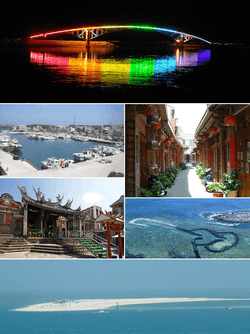 | |
 Flag  Logo | |
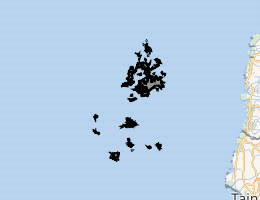
| |
 | |
| Coordinates: 23°35′N 119°35′E | |
| Country | Republic of China |
| Province | Taiwan Province (streamlined) |
| Seat | Magong City |
| Largest city | Magong |
| Boroughs | One city, five rural townships |
| Government | |
| • County Magistrate | Lai Feng-wei (KMT) |
| Area | |
| • Total | 141.052 km2 (54.460 sq mi) |
| Area rank | 22 of 22 |
| Population (December 2014) | |
| • Total | 101,758 |
| • Rank | 21 of 22 |
| • Density | 720/km2 (1,900/sq mi) |
| Time zone | UTC+8 (National Standard Time) |
| ISO 3166 code | TW-PEN |
| Website | www.penghu.gov.tw |
| Symbols | |
| Bird | Small Skylark (Alauda gulgula) |
| Flower | Firewheel (Gaillardia pulchella) |
| Tree | Chinese Banyan (Ficus microcarpa) |
| Penghu Islands | |||||||||||||||||||||||||||||||
|---|---|---|---|---|---|---|---|---|---|---|---|---|---|---|---|---|---|---|---|---|---|---|---|---|---|---|---|---|---|---|---|
| Traditional Chinese | 澎湖群島 | ||||||||||||||||||||||||||||||
| Postal | Pescadores Islands | ||||||||||||||||||||||||||||||
| |||||||||||||||||||||||||||||||
| Penghu Island | |||||||||||||||||||||||||||||||
| Traditional Chinese | 澎湖島 | ||||||||||||||||||||||||||||||
| |||||||||||||||||||||||||||||||
| Penghu County | |||||||||||||||||||||||||||||||
| Traditional Chinese | 澎湖縣 | ||||||||||||||||||||||||||||||
| |||||||||||||||||||||||||||||||
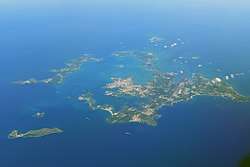
Name
The traditional name of the islands, the Pescadores, comes from the Portuguese name Ilhas dos Pescadores ("Fishermen Islands"). The European Portuguese pronunciation is [pɨʃkɐˈðoɾɨʃ] but, in English, it is typically closer to /ˌpɛskəˈdɔːrɪz, -iːz/. The islands have also been called Pehoe from the Minnan name Phêⁿ-ô·.[1] Using romanization based on the Mandarin pronunciation for the Chinese name, the islands have also been referred to as "Penghu Liehtao".
History
Prehistory
Penghu 1, a fossil jaw (mandible) dating to the late Pleistocene that belonged to a member of an extinct hominin species, was discovered in the Pescadores Channel around 2008.
Finds of fine red cord-marked pottery indicate that Penghu was visited by people from southwestern Taiwan around 5,000 years ago, though not settled permanently.[2]
Han Chinese from southern Fujian began to establish fishing communities on the islands in the 9th and 10th centuries,[2] and representatives were intermittently stationed there by the Southern Song and Yuan governments from around 1170.[3]
Wang Dayuan gave a detailed first-hand account of the islands in his Daoyi Zhilüe (1349).[4]
Ming dynasty
In the 15th century, the Ming ordered the evacuation of the islands as part of their maritime ban. When these restrictions were removed in the late 16th century, legal fishing communities were re-established on the islands. These fishermen worshipped at the Mazu Temple that gave Magong its name and themselves gave rise to the Portuguese and English name Pescadores.[3] The Ming established a permanent military presence starting in 1597.[5]
At this time, the Dutch East India Company was trying to force China to open a port in Fujian to Dutch trade and expel the Portuguese from Macau.[6][7][8] When the Dutch were defeated by the Portuguese at the Battle of Macau in 1622, they seized Penghu, built a fort there, and threatened raids on Chinese ports and shipping unless the Chinese allowed trading with them on Penghu and that China not trade with Manila.[9] In response, the Chinese governor of Fujian demanded that the Dutch withdraw from Penghu to Taiwan, where the Chinese would permit them to engage in trade.[10][11] The Dutch continued to raid the Fujian coast between October 1622 and January 1624 to force their demands, but were unsuccessful.[12] In 1624, the new governor of Fujian sent a fleet of 40–50 warships with 5,000 troops to Penghu and expelled the Dutch, who moved to Fort Zeelandia on Taiwan.[13][14]
Qing dynasty
For a period in the mid-17th century, Taiwan and the archipelago were ruled by the Koxinga kingdom (Kingdom of Tungning), which was overthrown by the Qing dynasty in 1683 after the Battle of Penghu.
The Penghu archipelago was captured by the French in March 1885, in the closing weeks of the Sino-French War, and evacuated four months later. The Pescadores Campaign was the last campaign of Admiral Amédée Courbet, whose naval victories during the war had made him a national hero in France. Courbet was among several French soldiers and sailors who succumbed to cholera during the French occupation of Penghu. He died aboard his flagship Bayard in Makung harbour on 11 June 1885.[15]
Empire of Japan
Towards the end of the First Sino-Japanese War, having defeated the Qing in northern China, Japan sought to ensure that it obtained Penghu and Taiwan in the final settlement. In March 1895, the Japanese defeated the Chinese garrison on the islands and occupied Makung. The Japanese occupation of Penghu, with its fine harbor, gave the Imperial Japanese Navy an advanced base from which their short-range coal-burning ships could control the Taiwan Straits and thus prevent more Chinese troops from being sent to Taiwan. This action persuaded the Chinese negotiators at Shimonoseki that Japan was determined to annex Taiwan, and, after Penghu, Taiwan and the Liaodong Peninsula had been ceded to Japan in the Sino-Japanese Treaty of Shimonoseki in April, helped to ensure the success of the Japanese invasion of Taiwan in May.[16]
Penghu County was then called the Hōko Prefecture by the Japanese government of Taiwan. During World War II, Makō (Makung) was a major base for the Imperial Japanese Navy and the embarkation point for the invasion of the Philippines.
Republic of China

In the Cairo Declaration of 1943, the United States, the United Kingdom and China stated it to be their purpose that "all the territories that Japan has stolen from the Chinese, such as Formosa and The Pescadores, shall be restored to the Republic of China". On 26 July 1945, the three governments issued the Potsdam Declaration, declaring that "the terms of the Cairo Declaration shall be carried out". However, the United States and the United Kingdom regard the aforementioned documents as merely wartime statements of intention with no binding force in law.
Following the surrender of Japan on 2 September 1945, Supreme Commander of the Allied Powers Douglas MacArthur issued General Order No. 1, which directed Japanese forces to surrender to the Allied Powers and facilitate the occupation of Japanese territories by the Allied Powers. In the Treaty of San Francisco, signed in 1951 and coming into effect in 1952, Japan renounced sovereignty over Taiwan and Penghu, but left their final disposition unsettled. The archipelago has been administered by the Republic of China since 1945.
Boat people fleeing Vietnam in the 1970s and 1980s and rescued by Taiwan's ships in the South China Sea were sent to the Penghu.[17]
On 25 May 2002, China Airlines Flight 611, a Boeing 747-200 aircraft flying from Taipei to Hong Kong, disintegrated and exploded over the Islands. The wreckage slammed into the Taiwan Strait, a couple of miles off the coast. All 225 passengers and crew on board were killed.[18]
Climate
Penghu County has a dry-winter humid subtropical climate (Köppen climate classification: Cwa), bordering on a regular humid subtropical climate (Köppen climate classification: Cfa).
| Climate data for Penghu (normals 1981–2010, extremes 1897–present) | |||||||||||||
|---|---|---|---|---|---|---|---|---|---|---|---|---|---|
| Month | Jan | Feb | Mar | Apr | May | Jun | Jul | Aug | Sep | Oct | Nov | Dec | Year |
| Record high °C (°F) | 28.6 (83.5) |
29.5 (85.1) |
30.8 (87.4) |
33.0 (91.4) |
34.2 (93.6) |
35.9 (96.6) |
36.7 (98.1) |
35.2 (95.4) |
35.1 (95.2) |
35.3 (95.5) |
31.1 (88.0) |
30.0 (86.0) |
36.7 (98.1) |
| Average high °C (°F) | 19.3 (66.7) |
19.6 (67.3) |
22.4 (72.3) |
26.0 (78.8) |
28.8 (83.8) |
30.6 (87.1) |
32.0 (89.6) |
31.8 (89.2) |
30.7 (87.3) |
28.1 (82.6) |
24.8 (76.6) |
21.1 (70.0) |
26.3 (79.3) |
| Daily mean °C (°F) | 16.9 (62.4) |
17.1 (62.8) |
19.5 (67.1) |
23.0 (73.4) |
25.7 (78.3) |
27.6 (81.7) |
28.7 (83.7) |
28.6 (83.5) |
27.8 (82.0) |
25.4 (77.7) |
22.4 (72.3) |
18.9 (66.0) |
23.5 (74.3) |
| Average low °C (°F) | 15.4 (59.7) |
15.4 (59.7) |
17.4 (63.3) |
20.9 (69.6) |
23.7 (74.7) |
25.6 (78.1) |
26.6 (79.9) |
26.5 (79.7) |
25.9 (78.6) |
23.9 (75.0) |
20.9 (69.6) |
17.4 (63.3) |
21.6 (70.9) |
| Record low °C (°F) | 7.7 (45.9) |
7.2 (45.0) |
7.4 (45.3) |
10.5 (50.9) |
16.6 (61.9) |
19.3 (66.7) |
21.8 (71.2) |
21.1 (70.0) |
19.2 (66.6) |
15.0 (59.0) |
9.6 (49.3) |
9.0 (48.2) |
7.2 (45.0) |
| Average rainfall mm (inches) | 17.5 (0.69) |
50.7 (2.00) |
59.5 (2.34) |
88.3 (3.48) |
118.3 (4.66) |
153.9 (6.06) |
157.7 (6.21) |
181.0 (7.13) |
112.7 (4.44) |
28.4 (1.12) |
21.2 (0.83) |
24.2 (0.95) |
1,013.4 (39.91) |
| Average rainy days (≥ 0.1 mm) | 5.0 | 7.2 | 8.9 | 9.4 | 9.7 | 10.1 | 7.7 | 8.8 | 6.8 | 2.2 | 3.6 | 4.1 | 83.5 |
| Average relative humidity (%) | 79.7 | 82.2 | 82.1 | 82.7 | 83.6 | 85.9 | 84.8 | 85.0 | 80.9 | 76.8 | 77.3 | 77.4 | 81.5 |
| Mean monthly sunshine hours | 111.5 | 94.7 | 125.2 | 148.8 | 179.3 | 200.4 | 264.8 | 240.4 | 213.8 | 189.9 | 139.1 | 123.3 | 2,031.2 |
| Source: Central Weather Bureau[19] | |||||||||||||
Government
.jpg)
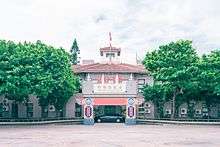
Penghu County is administered by Penghu County Government headed by Magistrate Lai Feng-wei of the Kuomintang and headquartered at the Penghu County Hall.
Administrative divisions
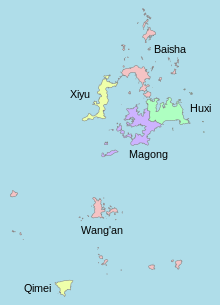
Penghu County is divided into one city and five rural townships. It is further divided into 97 villages.[20] Like Lienchiang County, Penghu County has no urban townships. The county seat is located at Magong City where it houses the Penghu County Hall and Penghu County Council.
| Type | Name | Chinese | Taiwanese | Hakka | English translation |
|---|---|---|---|---|---|
| City | Magong City | 馬公市 | Má-keng | Mâ-kûng | Originally Mazu Temple (媽宮) |
| Rural townships |
Huxi | 湖西鄉 | Ô͘-sai | Fù-sî | Lake West / West of Penghu |
| Baisha | 白沙鄉 | Pe̍h-soa | Pha̍k-sâ | White Sand | |
| Xiyu | 西嶼鄉 | Sai-sū | Sî-yí | Western Isle | |
| Wangan (Wang-an, Wang'an) | 望安鄉 | Bāng-oaⁿ | Mong-ôn | Hope Safe (網垵) | |
| Cimei (Qimei) | 七美鄉 | Chhit-bí | Tshit-mî | Seven Beauties (大嶼) |
The main islands of Magong City/Huxi Township, Baisha Township, and Xiyu Township are the three most populous islands and are connected via bridges. Two shorter bridges connect Huxi and Baisha. The Penghu Great Bridge connecting Baisha and Xiyu is the longest bridge in Taiwan.
Politics
The county elects a single representative to the Legislative Yuan. In the 2016 Republic of China legislative election, this seat was won by the Democratic Progressive Party with 55.4% of the vote.[21]
Political dispute
Despite the controversy over the political status of Taiwan, both the Republic of China and the People's Republic of China agree that Penghu is a county in (their own respective) "Taiwan Province" (Taiwan Province, Republic of China and Taiwan Province, People's Republic of China). However, geographically, the island of Taiwan does not include Penghu, although it is closer to Taiwan than mainland China. Thus, Penghu is listed separately from "Taiwan" in some contexts, e.g. the Separate Customs Territory of Taiwan, Penghu, Kinmen, and Matsu (the official WTO name for the Republic of China) in the Treaty of Shimonoseki, the Cairo Declaration, and the Treaty of San Francisco (see above).
Economy
Due to its restricted geography, fisheries have been the main industry for Penghu.[22] The Agriculture and Fisheries Bureau of the Penghu County Government governs matters related to agriculture and fisheries in Penghu. In 2016, the bureau placed a ban on the harvesting of sea urchins due to their declining population. However, the ban was lifted in 2017 but catches are limited only to those species larger than 8 cm (3.1 in) in diameter.[23]
Demographics
| Year | Pop. | ±% |
|---|---|---|
| 1985 | 102,282 | — |
| 1990 | 95,932 | −6.2% |
| 1995 | 90,937 | −5.2% |
| 2000 | 89,496 | −1.6% |
| 2005 | 91,785 | +2.6% |
| 2010 | 96,918 | +5.6% |
| 2015 | 102,304 | +5.6% |
| Source: "Populations by city and country in Taiwan". Ministry of the Interior Population Census. May 2018. | ||
Education
Education-related matters in Penghu County are administered under the Education Department of the Penghu County Government. The county houses the National Penghu University of Science and Technology.
Energy
Penghu is powered by the Chienshan Power Plant, a 140 MW diesel-fired power plant commissioned in 2001, and the Hujing Power Plant on Table Island. On 24 December 2010, the Taiwan-Penghu Undersea Cable Project of Taipower was approved by the Executive Yuan to connect the electrical grid in Taiwan Island to Penghu.[24]
Under a wind power development project approved in 2002 by the Executive Yuan, the ROC government plans to set up a total of 200 wind turbines in Penghu within 10 years. However, only 14 turbines have been set up as of 2015. On 1 October 2015, Taipower announced the construction of another 11 new wind turbines across the island, of which six will be constructed in Huxi Township and five in Baisha Township.[25]
The current total desalination capacity of the county to provide clean water to its residents is 15,500 m3 per day. To reduce its groundwater use, in November 2015 the county secured a contract of building an additional desalination plant with 4,000 m3 capacity per day, construction of which is expected to be completed by May 2018.[26]
Tourism
The Penghu National Scenic Area was established in the early 1990s, comprising most of the islands and islets of the archipelago. Tourism has since become one of the main sources of income of the county.
Historical sites include Central Street, Mazu Temple, Four-eyed Well, Penghu Reclamation Hall, Qimei Lighthouse, Siyu Eastern Fort, Jinguitou Fortress and Siyu Western Fort. Museums in the county are Chuwan Crab Museum, Ocean Resources Museum, Chang Yu-sheng Memorial Museum and Penghu Living Museum. Other attractions in the county include the Double-Heart of Stacked Stones, Fenggui Cave, Little Taiwan, Whale Cave, Xiaomen Geology Gallery and South Penghu Marine National Park.[27]
Since 1 January 2015, tourists from Mainland China can directly apply for the Exit & Entry Permit upon arrival in Penghu. This privilege also applies to Kinmen and the Matsu Islands as a means to boost tourism in the outlying islands of Taiwan.[28]
The county welcomed 1.8 million tourists in 2018 with an average annual growth of around 10%.[29]
 Original 1908 memorial to the cruiser Matsushima pictured. Modern park memorial in Magong City, Penghu, Taiwan.
Original 1908 memorial to the cruiser Matsushima pictured. Modern park memorial in Magong City, Penghu, Taiwan.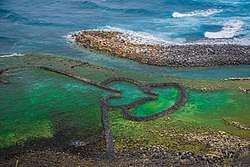
Drug smuggling
As a lightly populated outlying island, Penghu presents as a trans-shipment hub for drug smuggling into Taiwan from China and the Philippines. The area has become a focus for a drug crackdown in recent years.[30][31][32]
In 2016, Chou Meng-hsiang (周盟翔), chief prosecutor of the Penghu District Prosecutors Office, "led an investigation team in Taiwan, including officers from the Coast Guard Administration, in a bid to bring (a) drug trafficking ring to justice." A joint investigation with Philippine and Chinese authorities spanning one and a half years resulted in the seizure of "22.6 kilograms of amphetamine, 11.4 kilograms of ephedrine, and about 40 kilograms of calcium chloride" with an estimated value of NT$123 million. Eight suspects were arrested in Cagayan, a small island in northern Philippines, but no Taiwanese nationals were charged in relation to the importation scheme.[33]
In 2017, media reported "the biggest-ever haul of drugs in the county’s history" when 506 kg of ephedrine was seized from a Chinese fishing boat off Penghu "as part of an ongoing crackdown on the area drug trade".[30] Ephedrine smuggling has increased in recent years as it has a similar structure to amphetamines and can be easily converted into methamphetamine. According to a Focus Taiwan report, "(It) can then be sold for ten times the price, in this case that would be more than NT$1 billion (US$33.33 million)."[31]
Despite the size of the drug seizure, only the five crew members of the Chinese fishing boat were detained in the operation, with authorities "unable to find the Taiwanese ship which should have turned up to take delivery of the drugs". It was unclear from media reports how the Taiwanese side of the smuggling operation knew to abort the rendezvous. The suppliers of the shipment also evaded capture. It was believed the drugs were destined to be transported from Penghu for distribution on Taiwan.[34]
Transport
Penghu is served by Magong Airport in Magong City and Qimei Airport in Cimei Township. Both airports opened in 1977. Daily Air Corporation operates flights between Penghu to Kaohsiung.
Magong Harbor hosts ferry connections with Kaohsiung, Tainan, Chiayi and Kinmen.
See also
- Administrative divisions of Taiwan
- List of cities in Taiwan
References
Citations
- Campbell, William (1903). "Explanatory Notes". Formosa under the Dutch: described from contemporary records, with explanatory notes and a bibliography of the island. London: Kegan Paul. p. 546. OCLC 644323041.CS1 maint: ref=harv (link)
- "Penghu Reclamation Hall". Archived from the original on 30 March 2012. Retrieved 22 December 2012.
- Wills (2006), p. 86.
- Thompson (1964), pp. 167–168.
- Young-tsu Wong (2017). China’s Conquest of Taiwan in the Seventeenth Century Victory at Full Moon. Springer. p. 82. ISBN 978-981-10-2247-0.
- Cooper (1979), p. 658.
- Freeman (2003), p. 132.
- Thomson (1996), p. 39.
- Shepherd (1993), p. 49.
- Covell (1998), p. 70.
- Wright (1908), p. 817.
- Wills (1998), pp. 368–369.
- Wills (1998), p. 369.
- Wills (2010), p. 70.
- Loir (1886), pp. 291–317.
- Takekoshi (1907), pp. 80–82.
- KAMM, HENRY (5 August 1981). "DESPITE PERILS AFLOAT, VIETNAMESE CONTINUE TO FLEE". The New York Times. CAMP ONE MAKUNG, Pescadores, Aug. 1.CS1 maint: location (link)
- Barron, Lisa (28 May 2002). "China Airlines safety record in the spotlight". Cable News Network LP, LLLP. Archived from the original on 28 August 2010. Retrieved 25 October 2010.
- "Climate". Central Weather Bureau.
- "Precinct". Penghu County Govermment. Retrieved 6 May 2019.
Penghu county consists of 1 city and 5 townships, which are Magong city, Huxi Township, Baisha Township, Xiyu Township, Wang-an Township and Qimei Township. The city and township comprise 97 villages.
- "2016 The 14th Presidential and Vice Presidential Election and The 9th Legislator Election".
- http://island.giee.ntnu.edu.tw/ISISA2004/ISISA8/107%204-2-C-4%20Liu%20Yin%20Yuh.pdf
- Chen, Chi-ching; Lin, Ko (11 May 2017). "Ban on sea urchin harvesting temporarily lifted in Penghu". Focus Taiwan. Retrieved 12 May 2017.
- "Taiwan power company-Taipower Events". Archived from the original on 17 May 2014. Retrieved 3 June 2014.
- "Taipower to help build Penghu into low-carbon county".
- "Penghu chief seeks support for desalination plant expansion".
- "Ferry service between Tainan and Penghu's Dongji kicks off | Society | FOCUS TAIWAN - CNA ENGLISH NEWS".
- "Annual ridership on Kinmen-Fujian ferry services tops 1.5 million".
- Shan, Shelley (29 October 2019). "Official clarifies following Han's Penghu ferry vow". Taipei Times. Retrieved 29 October 2019.
- "Largest-ever haul of drugs found off Penghu, police say - Taipei Times". www.taipeitimes.com.
- "More details revealed about drug bust off Penghu | Society | FOCUS TAIWAN - CNA ENGLISH NEWS". focustaiwan.tw.
- "President orders all-out effort to combat drugs | Society | FOCUS TAIWAN - CNA ENGLISH NEWS". focustaiwan.tw.
- "Taiwan, China, Philippines bust drug trafficking ring | Society |". FOCUS TAIWAN.
- "Massive drugs catch on Chinese fishing boat n..." Taiwan News.
Works cited
- Cooper, J. P., ed. (1979). The New Cambridge Modern History IV: The Decline of Spain and the Thirty Years War, 1609–59. 4 (reprint ed.). CUP Archive. ISBN 978-0-521-29713-4. OCLC 655601868.CS1 maint: ref=harv (link)
- Covell, Ralph R. (1998). Pentecost of the Hills in Taiwan: The Christian Faith Among the Original Inhabitants (illustrated ed.). Hope Publishing House. ISBN 978-0-93-272-790-9. OCLC 833099470.CS1 maint: ref=harv (link)
- Freeman, Donald B. (2003). Straits of Malacca: Gateway or Gauntlet?. McGill-Queen's Press - MQUP. ISBN 978-0-7735-2515-3. OCLC 2004401056.CS1 maint: ref=harv (link)
- Loir, Maurice (1886). L'escadre de l'amiral Courbet. Paris: Berger-Levrault. LCCN 03013530. OCLC 23421595.CS1 maint: ref=harv (link)
- Shepherd, John Robert (1993). Statecraft and Political Economy on the Taiwan Frontier, 1600–1800 (illustrated ed.). Stanford University Press. ISBN 978-0-8047-2066-3. OCLC 25025794.CS1 maint: ref=harv (link)
- Takekoshi, Yosaburō (1907). Japanese rule in Formosa. London, New York, Bombay and Calcutta: Longmans, Green, and co. OCLC 753129. OL 6986981M.CS1 maint: ref=harv (link)
- Thompson, Lawrence G. (1964). "The earliest eyewitness accounts of the Formosan aborigines". Monumenta Serica. 23: 163–204. doi:10.1080/02549948.1964.11731044. JSTOR 40726116.CS1 maint: ref=harv (link)
- Thomson, Janice E. (1996). Mercenaries, Pirates, and Sovereigns: State-Building and Extraterritorial Violence in Early Modern Europe (reprint ed.). Princeton University Press. ISBN 978-1-4008-2124-2. OCLC 860392554.CS1 maint: ref=harv (link)
- Wills, John E., Jr. (1998). "Relations with maritime Europeans, 1514–1662". In Twitchett, Denis C.; Mote, Frederick W. (eds.). The Cambridge History of China: Volume 8, The Ming Dynasty, 1368–1644, Part 2. Cambridge University Press. pp. 333–375. ISBN 978-0-521-24333-9.CS1 maint: ref=harv (link)
- —— (2006). "The Seventeenth-century Transformation: Taiwan under the Dutch and the Cheng Regime". In Rubinstein, Murray A. (ed.). Taiwan: A New History. M.E. Sharpe. pp. 84–106. ISBN 978-0-7656-1495-7. OL 8055024M.CS1 maint: ref=harv (link)
- —— (2010). "Maritime Europe and the Ming". In Wills, John E., Jr. (ed.). China and Maritime Europe, 1500–1800: Trade, Settlement, Diplomacy, and Missions. Cambridge University Press. pp. 24–77. ISBN 978-0-521-43260-3. OL 24524224M.CS1 maint: ref=harv (link)
- Wright, Arnold (1908). Cartwright, H. A. (ed.). Twentieth century impressions of Hongkong, Shanghai, and other treaty ports of China: their history, people, commerce, industries, and resources, Volume 1. Lloyds Greater Britain publishing company. OL 13518413M.CS1 maint: ref=harv (link)
Further reading
- Cook, Harold John (2007). Matters of Exchange: Commerce, Medicine, and Science in the Dutch Golden Age. Yale University Press. ISBN 978-0-300-13492-6.
- Deng, Gang (1999). Maritime Sector, Institutions, and Sea Power of Premodern China. Greenwood Publishing Group. ISBN 978-0-313-30712-6.
- Idema, Wilt Lukas, ed. (1981). Leyden Studies in Sinology: Papers Presented at the Conference Held in Celebration of the Fiftieth Anniversary of the Sinological Institute of Leyden University, December 8-12, 1980. Volume 15 of Sinica Leidensia. Rijksuniversiteit te Leiden. Sinologisch instituut (illustrated ed.). BRILL. ISBN 978-90-04-06529-1.
- Li, Qingxin (2006). Maritime Silk Road. Translated by William W. Wang. China Intercontinental Press. ISBN 978-7-5085-0932-7.
- Parker, Edward Harper, ed. (1917). China, Her History, Diplomacy, and Commerce: From the Earliest Times to the Present Day (2nd ed.). J. Murray. LCCN 17030891. OL 6603922M.
External links
- Penghu County Government (in English)
- Penghu Tour Official Website
- 澎湖研究學術研討會 第1-8屆論文輯全球資訊網-歷屆論文 (Traditional Chinese)
- Living Museum (Copyright © 2012 Culture Taiwan)



